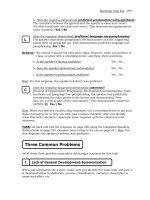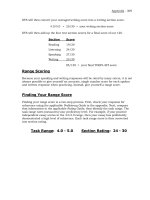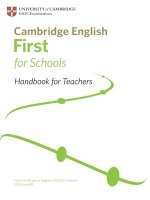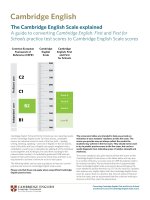First for schools reading paper part 1
Bạn đang xem bản rút gọn của tài liệu. Xem và tải ngay bản đầy đủ của tài liệu tại đây (169.5 KB, 11 trang )
First for Schools Reading Paper: Part 1 – teacher’s notes
Description
This activity trains students in good exam technique. They skim read to determine the gist of
the text. They then look at the questions and try to identify correct / incorrect options, giving
reasons.
Time required:
50 minutes
Materials
required:
Student’s Worksheets 1, 2, 3 and 4 (one copy of one worksheet per
student: see below)
Sample Task text (one per student)
Aims:
Sample Task questions (one per student)
to encourage students to skim read the text before answering the
questions
to help students to identify correct options and eliminate incorrect
options in multiple choice tasks
Procedure
1. Before the class, copy the Student’s Worksheets so that one quarter of the class has
Student’s Worksheet 1, one quarter has Student’s Worksheet 2, one quarter has
Student’s Worksheet 3 and one quarter has Student’s Worksheet 4.
2. Discuss the following questions briefly:
What sports do you play?
Do you take part in competitions?
If so, how do you feel before, during and after the competition?
Write some of the feelings on the board, e.g. tense, nervous, focussed, excited,
relieved, happy, disappointed.
3. Give out the Sample Task text and ask students to look at the photograph only.
Elicit the sport being played. If they don’t know what the sport is called, ask the
students to find the name in the first few lines of the text. (squash)
4. Tell students they have one minute to skim read the text (read it very quickly) to see
what it is about. Remind them of the different reading skills you discussed in the
activity: First for Schools Reading Paper: Overview. (It’s about a boy called Jamie
playing a squash match. Accept any extra information, e.g. “against a boy called
Danny”.)
5. Elicit or tell the class what kind of task they have to do in Part 1 of the Reading paper
(multiple choice task; 8 questions or incomplete sentences followed by four options).
Divide the class into 4 groups (A, B, C and D). The groups should be of around 4
students, so if your class is large, have 2 or 3 ‘A’ groups, 2 or 3 ‘B’ groups, etc.
Explain that each group is going to get all the “stems” (questions or incomplete
© UCLES 2009. This material may be photocopied (without alteration) and distributed for classroom use provided no charge is made. For further
information see our Terms of Use at />
First for Schools Reading Paper: Part 1 – teacher’s notes
www.teachers.cambridgeesol.org
Page 1 of 11
sentences) and one option for each question – so Group A will get all the A options,
Group B all the B options, Group C all the C options and Group D all the D options.
6. Give Student’s Worksheet 1 to Group A, Student’s Worksheet 2 to Group B,
Student’s Worksheet 3 to Group C and Student’s Worksheet 4 to Group D. Each
student should have a copy of the relevant worksheet.
7. Students work in pairs within their groups. They should look at the stems and the
option they have for each question. Then they should read the text carefully to decide
whether the option they have is correct or not. If they think an option is correct, they
underline the part of the text which confirms their answer. Point out that an option
may possibly be true, but that if it isn’t stated in the text, then the option will not be
correct. When they have decided in their pairs, they should compare answers with
the rest of their group and come to a group decision.
8. Now rearrange the class into groups of 4, so that each group has a representative
from A, B, C and D. They compare their answers for each question and agree in their
new groups on the correct answer (only one option can be correct). They should
underline the part of the text which contains each answer. Monitor the discussions.
9. Now give each student a copy of Sample Task: questions and all the options, so
they can see the complete test and have a copy to keep. Ask for whole class
feedback and put the correct answers on the board (see Key below).
10. Ask the following questions:
Did you read through the whole text before you tried to answer the
questions? (this strategy is recommended, as it helps candidates to locate the
appropriate part of the text for each question and gives them a general
understanding of the text before they look at the options.)
Did the questions come in the same order as the information in the text?
(Yes. Part 1 questions are always in the same order as the text.)
Did finding the answer to each question involve finding a single word or
phrase in the text? (No, apart from in question 2. In most questions,
candidates need to understand a section of the text in order to be able to
answer correctly. Using single words which match something in the question is
likely to lead to a wrong answer.)
11. Suggest/elicit a strategy for doing multiple choice questions like this:
First skim read the text quickly for gist.
Then look at the questions and try to find which part of the text answers the
question.
Then look at the options and try to determine which one is correct.
Additional information
Each correct answer in Part 1 receives 2 marks.
Part 1 consists of a text, followed by eight 4-option multiple choice questions which
test the understanding of content and text organisation. The text may be taken from,
© UCLES 2009. This material may be photocopied (without alteration) and distributed for classroom use provided no charge is made. For further
information see our Terms of Use at />
First for Schools Reading Paper: Part 1 – teacher’s notes
www.teachers.cambridgeesol.org
Page 2 of 11
for example, an article or a modern novel. Questions may focus on the main ideas or
details in the text, and on the attitudes or opinions expressed. Candidates may also
be asked to deduce the meaning of a word or phrase (e.g. in qu. 8) and to
demonstrate understanding of references, such as pronouns, within the text (e.g. in
qu. 2). Additionally, questions may focus on the tone of the text or the writer’s
purpose, as well as the use of exemplification or comparison. These questions may
require candidates to infer the meaning from clues in the text, a skill which is an
essential part of reading ability.
The 4-option multiple choice questions are presented in the same order as the
information in the text so that candidates can follow the development of the writer’s
ideas as they work through the questions. The final question may require candidates
to interpret an aspect of the text as a whole.
Warn your students about the risks of ‘word spotting’, that is assuming that an option
must be correct simply because it contains a word that is also in the text. Students
need to check that the meaning of an option is reflected in the text, not that one word
is the same in both.
When the questions take the form of incomplete sentences, encourage your students
to read both parts of the sentence carefully. They need to check that the whole
sentence matches what is written in the text and not just the phrase in option A, B, C
or D.
Make sure your students read texts in which opinions, ideas and attitudes are
expressed, such as interviews with well-known people in which they explain how they
started out in their field and what they believe helped them to be successful, or
extracts from novels which focus on characters’ feelings.
Suggested follow-up activities
In a future class, practise doing a past First for Schools Reading Paper Part 1 using
these techniques.
Past papers for First for Schools will be available in 2011.
© UCLES 2009. This material may be photocopied (without alteration) and distributed for classroom use provided no charge is made. For further
information see our Terms of Use at />
First for Schools Reading Paper: Part 1 – teacher’s notes
www.teachers.cambridgeesol.org
Page 3 of 11
First for Schools Reading Paper: Part 1 – answer key
Key to Sample Task
1. B
2. D
3. A
4. C
5. D
6. B
7. A
8. D
© UCLES 2009. This material may be photocopied (without alteration) and distributed for classroom use provided no charge is made. For further
information see our Terms of Use at />
First for Schools Reading Paper: Part 1 – answer key
www.teachers.cambridgeesol.org
Page 4 of 11
First for Schools Reading Paper: Part 1 Student’s Worksheet 1
Look at questions 1–8 about the Sample Task text and decide whether the answer given is
correct or incorrect.
If you think it is correct, underline the part of the text where you found the answer.
1. In the first paragraph, Jamie noticed that Danny
A. wasn't happy with the way he was playing.
2. What does 'it' refer to in line 12?
A. the winner
3. What did Jamie feel when he looked at the gallery?
A. anxiety about what his father would be thinking
4. In the fourth paragraph, how did Jamie react to the ball?
A. He misjudged where it was going to land.
5. What do we learn about Joe in the fifth paragraph?
A. He didn't think Danny was a good player.
6. What did Jamie realise in the sixth paragraph?
A. He should have concentrated harder on his practice.
7. What did Jamie think when Danny argued with Geoff?
A. He expected Geoff to stick to his decision.
8. In the last paragraph, the expression 'played with him like a toy' is used to illustrate
the fact that
A. the match had become more entertaining.
© UCLES 2009. This material may be photocopied (without alteration) and distributed for classroom use provided no charge is made. For further
information see our Terms of Use at />
First for Schools Reading Paper: Part 1 Student’s Worksheet 1
www.teachers.cambridgeesol.org
Page 5 of 11
First for Schools Reading Paper Part 1 Student’s Worksheet 2
Look at questions 1–8 about the Sample Task text and decide whether the answer given is
correct or incorrect.
If you think it is correct, underline the part of the text where you found the answer.
1. In the first paragraph, Jamie noticed that Danny
B. wasn't quite so sure of himself as he had been.
2. What does 'it' refer to in line 12?
B. the club
3. What did Jamie feel when he looked at the gallery?
B. pride that his father was watching him
4. In the fourth paragraph, how did Jamie react to the ball?
B. He thought it wasn't a good shot.
5. What do we learn about Joe in the fifth paragraph?
B. He attempted to stop Danny’s opponents shouting.
6. What did Jamie realise in the sixth paragraph?
B. He was tired of the constant pressure he felt.
7. What did Jamie think when Danny argued with Geoff?
B. He knew Geoff might ask for his opinion.
8. In the last paragraph, the expression 'played with him like a toy' is used to illustrate
the fact that
B. the match had gone on for too long.
© UCLES 2009. This material may be photocopied (without alteration) and distributed for classroom use provided no charge is made. For further
information see our Terms of Use at />
First for Schools Reading Paper Part 1 Student’s Worksheet 2
www.teachers.cambridgeesol.org
Page 6 of 11
First for Schools Reading Paper: Part 1 Student’s Worksheet 3
Look at questions 1–8 about the Sample Task text and decide whether the answer given is
correct or incorrect.
If you think it is correct, underline the part of the text where you found the answer.
1. In the first paragraph, Jamie noticed that Danny
C. was annoyed by the noise from the spectators.
2. What does 'it' refer to in line 12?
C. the atmosphere
3. What did Jamie feel when he looked at the gallery?
C. annoyance that Danny had more supporters
4. In the fourth paragraph, how did Jamie react to the ball?
C. He decided it wasn’t worth trying to hit it.
5. What do we learn about Joe in the fifth paragraph?
C. He thought Powell should praise his son more.
6. What did Jamie realise in the sixth paragraph?
C. He didn't need to worry so much about his skills.
7. What did Jamie think when Danny argued with Geoff?
C. He wondered how Geoff would react.
8. In the last paragraph, the expression 'played with him like a toy' is used to illustrate
the fact that
C. Jamie was no longer serious about winning.
© UCLES 2009. This material may be photocopied (without alteration) and distributed for classroom use provided no charge is made. For further
information see our Terms of Use at />
First for Schools Reading Paper: Part 1 Student’s Worksheet 3
www.teachers.cambridgeesol.org
Page 7 of 11
First for Schools Reading Paper: Part 1 Student’s Worksheet 4
Look at questions 1–8 about the Sample Task text and decide whether the answer given is
correct or incorrect.
If you think it is correct, underline the part of the text where you found the answer.
1. In the first paragraph, Jamie noticed that Danny
D. was being more aggressive than usual in his game.
1. What does 'it' refer to in line 12?
D. the semi-final
2. What did Jamie feel when he looked at the gallery?
D. pleasure that his friends were watching
4. In the fourth paragraph, how did Jamie react to the ball?
D. He tried to hit it and missed.
5. What do we learn about Joe in the fifth paragraph?
D. He had little effect on Powell's behaviour.
6. What did Jamie realise in the sixth paragraph?
D. He should be more ambitious for the future.
7. What did Jamie think when Danny argued with Geoff?
D. He hoped Geoff would sort the problem out quickly.
8. In the last paragraph, the expression 'played with him like a toy' is used to illustrate
the fact that
D. Jamie had little control over the match.
© UCLES 2009. This material may be photocopied (without alteration) and distributed for classroom use provided no charge is made. For further
information see our Terms of Use at />
First for Schools Reading Paper: Part 1 Student’s Worksheet 4
www.teachers.cambridgeesol.org
Page 8 of 11
First for Schools Reading Paper: Part 1 – Sample Task: text
Questions 1–8
You are going to read an extract from a novel. For questions 1 – 8, choose the answer (A, B, C or D) which
you think fits best according to the text.
Mark your answers on the separate answer sheet.
__________________________________________________________________________________
Jamie tried to ignore the shouts from the spectators, urging the
players on. Across the squash court, Danny Powell glared back at
him. But there was an element of satisfaction in Danny's face. His
arrogance had gone – the first two games had at least knocked
that a bit – but having fought back with characteristic aggression
to two games all, he clearly felt he was in with a chance of taking
the match.
line 12
Jamie tried to focus his mind and energy. He knew the pressure
was on him now. He had been two games ahead and had thrown
that lead away. Though this was meant to be a minor event, the
semi-final of the Under 19 Knockout in the 'friendly' atmosphere of their own club, it was obvious that
everyone wanted to know who the winner would be, as they saw it as a taster for the Regional
Championships in two weeks' time.
Jamie glanced up at the faces in the gallery. Their classmates were all there, and, of course, Bob Powell,
who was going on and on with pride every time Danny won a point, as though his son were a superstar
and not the show-off that he was. But there was only one face up there Jamie was bothered about – his
own father's. And right now, he did not dare to look at it.
'Fifth and final game,' called Geoff, the umpire. The shouts from the gallery died away and Jamie forced
his mind back to the match. Danny served. Jamie started to dive forward. Earlier in the match, he would
have reached this shot, but now, with his energy almost spent, he stopped, knowing it was out of reach,
anxious to save what strength he had left.
Powell's voice bellowed out: 'Good boy, Danny, good boy! He's finished!' Jamie heard disapproving noises
from Joe who, as owner of the club, always tried to limit Powell's open hostility towards his son's
opponents. It never did any good.
Jamie turned back to the court, determined to fight back, but now desperately jaded. It seemed to him
suddenly that he'd been on a squash court every waking moment of his sixteen years. And before the
next ball came towards him, he just had time to reflect that this wasn't far from the truth. No wonder
these walls had come to feel like a prison cell; and it was a cell of tension, with moments of victory, but
dominated for the most part by an ambition he sensed he would never fulfil.
The next point was given to Jamie. Danny turned to Geoff: 'It was out.' Jamie looked away. He knew it
was his point but he didn't expect a problem. Geoff was not a person to be fazed by anyone, not even
Danny or his father. 'Come on,' said Danny. 'It was my point.' Jamie had heard this sort of dialogue so
many times from Danny and, if it went on long enough, which it usually did, Bob Powell was bound to
join in. 'I've given my decision,' said Geoff. 'Now play on.'
Jamie said nothing and continued to wait, ball in hand. In a strange way, he was grateful for this
interruption. It gave him a moment to catch his breath. But not for long. Geoff leaned on the rail and
fixed his eyes on Danny. 'Danny, play on, please, or I'll award a penalty point.' Danny, with a final glare,
walked back into position to continue the match. Jamie served at once, hoping the incident would have
unsettled Danny's rhythm.
But Danny was now fired up. The ball came back like a bullet. To Jamie, the next four points seemed to
fly past in a maze of volleys and smashes that forced him back, pulled him forward, played with him like
© UCLES 2009. This material may be photocopied (without alteration) and distributed for classroom use provided no charge is made. For further information see our
Terms of Use at />
First for Schools Reading Paper: Part 1 – Sample Task: text
www.teachers.cambridgeesol.org
Page 9 of 11
a toy. He knew then that he could not beat Danny. Not today. Perhaps not ever. Danny was too strong.
1
In the first paragraph, Jamie noticed that Danny
A
B
C
D
2
What does 'it' refer to in line 12?
A
B
C
D
3
the
the
the
the
winner
club
atmosphere
semi-final
What did Jamie feel when he looked at the gallery?
A
B
C
D
4
wasn't happy with the way he was playing.
wasn't quite so sure of himself as he had been.
was annoyed by the noise from the spectators.
was being more aggressive than usual in his game.
anxiety about what his father would be thinking
pride that his father was watching him
annoyance that Danny had more supporters
pleasure that his friends were watching
In the fourth paragraph, how did Jamie react to the ball?
A
B
C
D
He
He
He
He
misjudged where it was going to land.
thought it wasn't a good shot.
decided it wasn’t worth trying to hit it.
tried to hit it and missed.
First for Schools Reading Paper: Sample Task questions
© UCLES 2009. This material may be photocopied (without alteration) and distributed for classroom use provided no charge is made. For further information see our
Terms of Use at />
First for Schools Reading Paper: Sample Task questions
www.teachers.cambridgeesol.org
Page 10 of 11
5
What do we learn about Joe in the fifth paragraph?
A
B
C
D
6
He
He
He
He
should have concentrated harder on his practice.
was tired of the constant pressure he felt.
didn't need to worry so much about his skills.
should be more ambitious for the future.
What did Jamie think when Danny argued with Geoff?
A
B
C
D
8
didn't think Danny was a good player.
attempted to stop Danny’s opponents shouting.
thought Powell should praise his son more.
had little effect on Powell's behaviour.
What did Jamie realise in the sixth paragraph?
A
B
C
D
7
He
He
He
He
He
He
He
He
expected Geoff to stick to his decision.
knew Geoff might ask for his opinion.
wondered how Geoff would react.
hoped Geoff would sort the problem out quickly.
In the last paragraph, the expression 'played with him like a toy' is used to illustrate the fact that
A
B
C
D
the match had become more entertaining.
the match had gone on for too long.
Jamie was no longer serious about winning.
Jamie had little control over the match.
© UCLES 2009. This material may be photocopied (without alteration) and distributed for classroom use provided no charge is made. For further information see our
Terms of Use at />
First for Schools Reading Paper: Sample Task questions
www.teachers.cambridgeesol.org
Page 11 of 11









